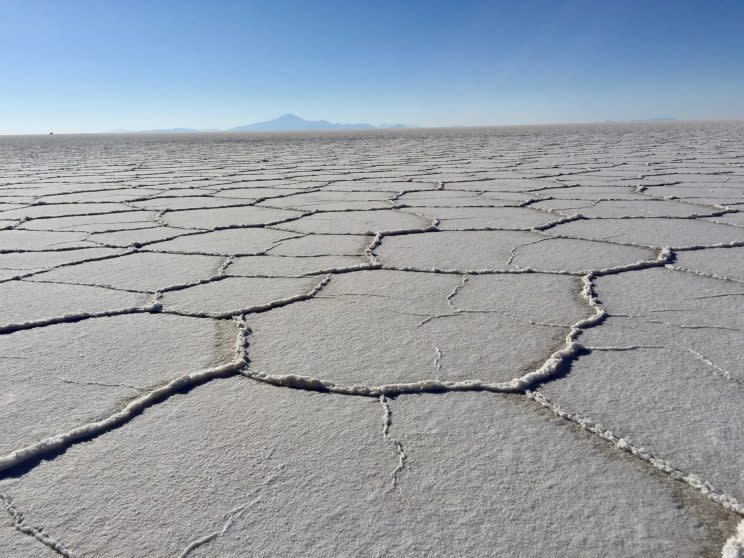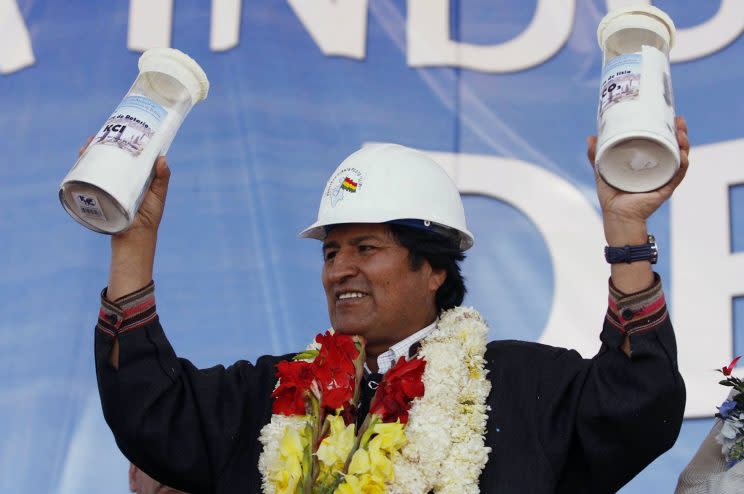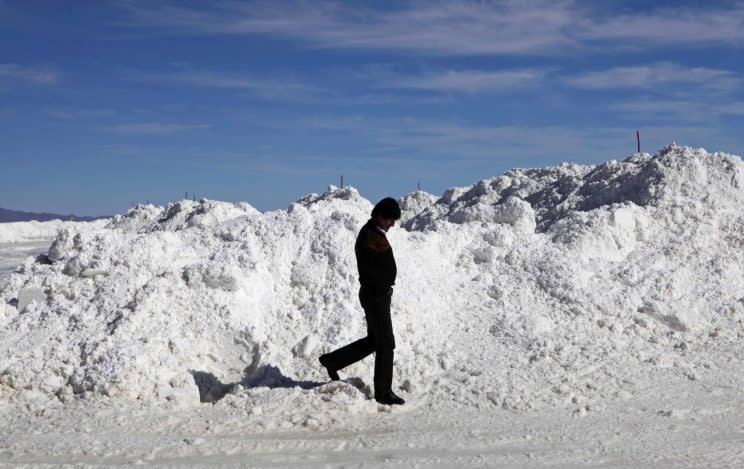Inside Bolivia’s long struggle to unlock the world’s largest lithium supply
Video by Laura Klairmont
At the heart of South America, the long-struggling nation of Bolivia sits atop an unlikely gold mine: the world’s largest lithium reserves.
It’s been nearly a decade since the Bolivian government first set out to capitalize on this precious natural resource. Yet while the booming tech industry has recently sent lithium prices soaring, Bolivia appears to have made little progress toward meeting this growing global demand.
But like the salt flats that cover Bolivia’s deep ocean of lithium and other minerals, there’s more to the country’s lithium industry than meets the eye. For the impoverished, landlocked nation whose natural resources have historically been pillaged by foreign powers, the struggle to independently profit from its vast lithium supply is symbolic of a larger national effort to fully emerge from beneath the shadow of its imperialist past.
In an attempt to propel the slow-growing lithium industry forward, earlier this year the Bolivian government proposed a plan to create a brand-new, state-run lithium mining corporation.
The latest endeavor, billed as a sustainable move toward monetizing the country’s bountiful lithium reserves, is just the latest in a series of similar initiatives the government has pursued over the years.
It may also be an effort to turn both the national and international spotlight back onto the efforts of President Evo Morales — a longtime champion of the country’s lithium project — ahead of his upcoming bid for reelection in 2019.
Repairing Bolivians’ historically fraught relationship with their country’s natural resources was a key tenet of Morales’ historic 2005 campaign to become Bolivia’s first indigenous president, and within his first hundred days in office he’d nationalized the country’s oil and gas industries. In 2009, Morales enacted a new Constitution — approved by national referendum — that expanded the rights of Bolivia’s historically oppressed indigenous majority, further enabling him to follow through on his promise to redistribute export profits into the pockets of the people.
Under Morales, a global commodities boom helped drive economic growth in Bolivia by an annual average of 5 percent. By the time Morales secured his third consecutive term in office in 2014 (despite having just imposed a two-term limit for presidents in his new Constitution five years prior), half a million Bolivians had managed to rise above the poverty line.
Despite these strides, Bolivia remains one of the poorest countries in South America. And the lithium project has yet to meet most of the lofty goals laid out by Morales when he first unveiled his plan in 2009 to transform Bolivia into a sort of socialist hybrid between Saudi Arabia and Detroit. Beyond retaining Bolivian control of the extraction process, Morales sought to create an entirely new national industry, promising to make the long-suffering landlocked nation into a leading global source for not only lithium, but Bolivian-made batteries and even electric cars.
Eight years later, Bolivia’s lithium industry consists of a single pilot plant, which finally shipped its first order of lithium carbonate to China this past September.
A little more than one year before that first big sale to China, a visit to the Llipi Loma Pilot Plant provided crucial insight into the roots of Bolivia’s fledgling lithium industry, and the obstacles to making Morales’ vision a reality — starting with the setting.
A valuable sea of minerals floating beneath the salt flats
The Llipi Loma plant sits at the edge of the world’s largest salt flat, a blindingly white expanse that looks more like the surface of a lifeless planet — or the set of a post-apocalyptic movie — than any earthly landscape.
“Here, there was no electricity, there was no water,” Marcelo Castro Romero, the plant’s then head of operations, said two summers ago, looking over the blank expanse. Beyond providing guided tours in the rare instances that journalists are allowed to visit the plant, Castro (who reportedly stepped down from his post this past September) appeared at the time intent on conveying the circumstances into which the facility and the entire lithium project had been born in an effort to explain its apparent state of paralysis.
“There was no communication, neither cellular nor Internet. There weren’t good roads; natural gas didn’t exist either,” he continued in Spanish, painting a picture of a not-so-distant past that required little imagination to envision. “It would’ve been faster to construct an entire building in Europe than to lay a brick here.”
It was late July 2015, the middle of Bolivia’s dry season, and the salt that washed across the Salar de Uyuni during the prior rainy months had formed a veneer of intricate geometric shapes. This lovely natural spectacle is often what draws adventurous travelers to Bolivia, but the salt flat is much more than a tourist attraction. Its real value is found not in its surface beauty but what lies beneath it: the world’s largest lithium reserves.

Once best known as an effective treatment for severe depression and bipolar disorder, lithium has more recently emerged as a key component in producing the lightweight batteries that power smartphones, flat-screen TVs and — increasingly — electric cars. Over the past few years, increased production of the latter by manufacturers like Tesla, General Motors and Toyota has driven up the global demand and cost of lithium.
In June, analysts with Bloomberg New Energy Finance predicted that by 2040, 35 percent of light vehicles (i.e. passenger cars and light-duty trucks) sold would be electric — approximately 90 times more than the number of electric vehicles sold in 2015 — creating a battery market worth an estimated $250 billion or more.
In the years since Morales first set his sights on the valuable sea of minerals floating beneath the flats, international media coverage had gone from enthusiastic to speculative to almost nonexistent as forward movement on the project seemed to grind to a halt.
So what was taking so long? The answer, it turns out, is that it’s impossible to truly assess the progress of Bolivia’s lithium project without first understanding its history.
A paradox of plenty
“Bolivians have always considered themselves beggars sitting on a throne of gold,” said Linda Farthing, a Latin America scholar and journalist who has co-authored three books on the country.
Home to a variety of natural resources including gas, silver, iron, tin, zinc and gold, like many resource-rich nations, Bolivia has fallen prey to what’s known as the “resource curse” or the “paradox of plenty,” the concept that countries dependent on resource extraction are often run by weak and corrupt governments.
Dating back to the Inca era, there are records of Bolivian leaders selling resources to foreign entities in deals that lined their own pockets while leaving the rest of the country poverty stricken and, in many places such as Uyuni, the town closest to the Salar, without basic amenities like heat or electricity.

“Sacar, ganar, y llevar,” said Anna Revette, a graduate student in sociology at Northeastern University who was doing her dissertation on the impact of lithium extraction on Bolivian society and development. Literally meaning “extract, make money and leave,” Revette explained, the refrain is commonly used by Bolivians to describe this painful pattern.
As a result, the country’s ample resources have come to represent more than just physical commodities. They’re “deeply rooted in the Bolivian imagination of what they could be,” said Farthing. “There is a very strong belief that if we could only get ahold of the resources and make them ours, we could be wealthy.”
It was against this backdrop that, shortly after taking office in 2006, Morales began nationalizing the country’s profitable resources, starting with the oil and gas industries, and eventually taking on lithium.
“Evo is very much a Bolivian,” Farthing said of Morales, who is often referred to by his first name. She argues that Morales’ rhetoric on resources was less about politics and infrastructure and more like the rallying cry of a social movement, creating “great enthusiasm that this is going to pull the country out of poverty, solve all the country’s problems.”

Those promises were particularly enticing to members of the 36 different indigenous groups that make up about 62 percent of Bolivia’s population. Despite their large numbers, native Bolivians had historically been marginalized and discriminated against. It wasn’t until 2009, four years after the election of the country’s first indigenous president, that the civil and political rights of Bolivia’s indigenous majority were officially codified in its Constitution.
From now on, Morales promised, the country’s resources would only be exploited for the good of all Bolivians. What’s more, he vowed that the new lithium industry would be entirely Bolivian-made — without any outside help or influence.
Symbolically, this plan sent a message to the world that Bolivia would no longer allow its resources to be plundered for the benefit of foreign corporations. Logistically, however, it would create a significant roadblock to efficiently getting Bolivia’s lithium industry off the ground.
Bolivian or bust
No country in the world has more lithium than Bolivia. Yet with its flimsy infrastructure and technology, few countries were perhaps less prepared for such an ambitious undertaking.
Modernizing Bolivia’s roads, for example, has been a major focus of Morales’ economic policy since he took office in 2006. Yet, despite reports that the Bolivian government constructed more miles of paved highway during Morales’ first decade in office than during the entire period between 1948 and 2000, as of 2010, only 8.5 percent of all roadways in Bolivia were paved, according to the CIA World Factbook.
Transportation is just one piece of Bolivia’s infrastructural handicap. As of 2013, 1.2 million people did not have access to electricity — placing Bolivia right below Kenya at 108th on the CIA’s list of world energy consumers. And by July 2015, more than a year after Bolivia launched its first telecommunications satellite, only 45.1 percent of the population was connected to the Internet.
Even after Morales softened his Bolivian-or-bust stance, eventually inviting international companies to participate in the process, he remained reluctant to heed the guidance of foreign experts.

In March 2012, Bolivia commissioned Korean steel manufacturer POSCO and state-owned Korea Resources Corp. to work with Comibol, the national mining agency, to develop the country’s first lithium plant. Less than five months after the joint venture was announced, the deal had gone south.
Walter Meierhofer’s Swiss company Salt & Evaporation Plants Ltd., or SEP, was one of the three finalists chosen to compete for a contract to build a lithium carbonate plant near the Salar de Uyuni in April 2015. Meierhofer and his team of engineers went to Bolivia to participate in a bidding process that was unlike any other they’d been a part of.
“It was very strange,” Meierhofer later told Yahoo News, explaining that, typically, when commissioned by corporate clients in Asia, the U.S., the Middle East and Europe, SEP handles all aspects of a plant’s development, including the extraction process.
But he soon learned upon arriving in Bolivia that “that’s not what they were looking for.”
The state-run mining agency, Meierhofer learned, was only interested in help with engineering and equipment, insisting that the winner of the contract was to use the Bolivian process that had already been developed in-house.
“We had the impression we could improve it to get more yield, but they didn’t take any notice of that,” Meierhofer said. “They seem to be convinced it’s working the way they’ve done it.”
“It’s really not clear what they’re doing,” he said, reflecting on his experience in Bolivia about a year later. “It’s all a bit weird what’s going on there.”
In the end, a German industrial salts firm called K-UTEC got the deal. Morales signed the contract in a televised ceremony last August during which he declared, “We’ve taken major steps toward the industrialization of lithium. These investments are our own money, we will have no partners. We will be the owners.”

The K-UTEC plant is expected to be up and running by the end of 2018, just two years before the end of Morales’ current term. Despite having lost a referendum last February to allow Morales a fourth term in office, the president’s Movimiento al Socialismo, or MAS, party voted unanimously in December to support him for reelection at the end of his third term in 2019.
Meanwhile, in the past year alone, the cost of lithium has skyrocketed, with companies constantly seeking new sources for the coveted commodity, from Canada to the Czech mountains.
“Right now you are sadly missing an opportunity,” Ton Chao-lin, South Korea’s ambassador in La Paz, said in July, suggesting that the Salar de Uyuni could still have a chance at becoming the world’s leading lithium supplier, if Bolivia would just pick up the pace.
Bolivia appears to be heeding that advice with its recent bid to replace the lithium division of Comibol, the government-run mining agency, with a separate state-run lithium corporation that will reportedly collaborate with both local and international companies to produce lithium batteries, among other products.
But before Castro, the former head of mine operations, left his post at Llipi Loma, he made it clear that Bolivia does not intend to move at any speed other than its own. And, while the country has yet to become an economic powerhouse, any progress made by the Bolivian lithium industry is significant — if only symbolically.
“Before President Morales was in government, the natural resources went out of the country,” Castro said. But now, “Bolivia’s resources are being industrialized by Bolivians for Bolivians,” he said. “Bolivia is on the path to human development.”
This piece was reported from Bolivia during a fellowship with the International Reporting Project [IRP]
Read more from Yahoo News:



